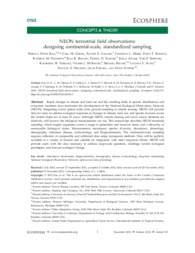NEON terrestrial field observations: designing continental-scale, standardized sampling.
NEON terrestrial field observations: designing continental-scale, standardized sampling.
Autoria: KAO, R. H.; GIBSON, C. M.; GALLERY, R. E.; MEIER, C. L.; BARNETT, D. T.; DOCHERTY, K. M.; BLEVINS, K. K.; TRAVERS, P. D.; AZUAJE, E.; SPRINGER, Y. P.; THIBAULT, K. M.; MCKENZIE, V. J.; KELLER, M.; ALVES, L. F.; HINCKLEY, E-L. S.; PARNELL, J.; SCHIMEL, D.
Resumo: Rapid changes in climate and land use and the resulting shifts in species distributions and ecosystem functions have motivated the development of the National Ecological Observatory Network (NEON). Integrating across spatial scales from ground sampling to remote sensing, NEON will provide data for users to address ecological responses to changes in climate, land use, and species invasion across the United States for at least 30 years. Although NEON remote sensing and tower sensor elements are relatively well known, the biological measurements are not. This manuscript describes NEON terrestrial sampling, which targets organisms across a range of generation and turnover times, and a hierarchy of measurable biological states. Measurements encompass species diversity, abundance, phenology, demography, infectious disease, ecohydrology, and biogeochemistry. The continental-scale sampling requires collection of comparable and calibrated data using transparent methods. Data will be publicly available in a variety of formats and suitable for integration with other long-term efforts. NEON will provide users with the data necessary to address large-scale questions, challenge current ecological paradigms, and forecast ecological change.
Ano de publicação: 2013
Tipo de publicação: Artigo de periódico
Unidade: Embrapa Territorial
Observações
1 - Por padrão são exibidas publicações dos últimos 20 anos. Para encontrar publicações mais antigas, configure o filtro ano de publicação, colocando o ano a partir do qual você deseja encontrar publicações. O filtro está na coluna da esquerda na busca acima.
2 - Para ler algumas publicações da Embrapa (apenas as que estão em formato ePub), é necessário ter, no celular ou computador, um desses softwares gratuitos. Sistemas Android: Google Play Livros; IOS: iBooks; Windows e Linux: software Calibre.
Acesse outras publicações
Acesse a Base de Dados da Pesquisa Agropecuária (BDPA) para consultar o acervo completo das bibliotecas da Embrapa.

